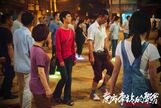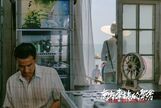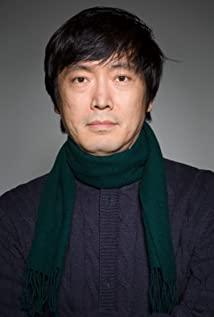In front of the train station, men and women are searching around the hard marble columns. The tall and silent columns, together with the high-speed trains, dislocately outline the "criminal paradise" in the film, which seems to be a different world. The columns and walls are like the edge of reality. A material remnant of the film constitutes the boundary between daily space and "different space", and also constitutes a metaphor for the fate of Zhou Zenong and Liu Ai'ai, which is the exit and the reality they desperately grasp in the despair of the criminal world. They stayed in the waiting room for a while, but returned the same way. People in this world want to escape but can't escape.
The opening of the space rhetoric of "The Gathering at the Southern Station" is a video invitation from the director Diao Yinan to the audience, inviting us to enter the underground rivers and lakes in the story, and at the same time enter the world constructed by his unique video logic . Even though this image logic can be logically attributed to some kind of Chinese-style "neo-noir", the space language presented by Antonioni in the "emotional trilogy" is constantly emerging in the author's mind while watching the film: Men and women are dodging each other in the architectural space, going out of the painting into the painting, peeping in the public space, relying on the architectural fulcrum in the scene scheduling, and the continuity of sight and action is abruptly broken. Such a highly radical image order/anti-order is shadowy in "Southern Station", but it is somewhat externalized into a certain image style that emphasizes the sense of movement and impact, just like the exquisite scene scheduling in the third opening shot of this film Texture with space: Passers-by men and women in the depth of field move to the left of the painting, and the camera pans to Zhou Zenong in front of the foreground column. He draws to the left of the painting. At this time, at the other end of the column in the depth of field, there is a shadow of Liu Ai'ai, who is covered with an umbrella. Pan down to a close-up of a cigarette in hand, and then pan to a close-up shot of Liu and Zhou's duo. Man-woman-building, under this image rhetoric, the characters appear in the way of concealment and hiding, peeping and following in public buildings, this dodging game brings out not the middle-class emotional estrangement, but the secret. Side exposure with desire. After all, compared to the questioning of modern world order and emotional norms in An’s films, Diao Yinan’s concern is more specific, and it is a certain absurdity, repression and alienation inherent in a specific spatial order and character relationships. Men and women are more like "bodies" than "characters", lines like bodies, shadow-like bodies, projected on walls, hidden in umbrellas and curtains, blended under the neon lights of buildings, or swept across advertisements The foreground of the card reflects the false "urban" depth of field, and the performance of the actors becomes the image fragments dragging down the order of the architectural space, an element equal to other image modeling. As the director mentioned in the interview, the performance is here. There is no emotional experience in the film, just the action itself.
This keen awareness of digging space makes Diao Yinan's black images have a strong feature that is different from traditional noir films, that is, the alienation of everyday space. The defamiliarization is so strong that even the most everyday things become a kind of spectacle, which can be comical, such as the glowing sneakers worn by the police during an arrest, or terrifying, such as from the The deadly skate shoes in "Fireworks in the Day", to the umbrella that came out of the body in "Southern Car Wars", this kind of bridge that completely dissolves "suspense" and highlights the sense of shock probably benefits from Diao Yinan's early years in Chinese dramas Embrace the nourishment of Western modernist drama. The reason for defamiliarizing daily life is to discover the internalized body of daily life, that is, repressed violence and surging lust. For Diao Yinan, "anti-daily" is the essence of daily life, and skate shoes are the hero and heroine. The way of emotional approach is also the symptomatic violence of asexual/castrated men. The umbrella is not only a mysterious body projection when a woman first appears, but also a bloody weapon for a man to finally kill the enemy. In a rather psychoanalytic expression, Diao Yinan presents the "face of reality" of reality, which is the ridiculous and terrifying inner essence of reality, a source of images unfiltered by rational order.
The "defamiliarization of everyday space" in "South Station" has been extended into a disordered essence of a certain order. Order/disorder is the core narrative logic of the film: a murder, an escape, a bounty, and a promise. The order of the rivers and lakes is no longer, and the emotions of people's hearts are unpredictable. At the story level, this film is somewhat too concise. And a disordered image lurks beneath the surface story. The map at the time of police deployment is an abstract order of lines and symbols, but once it enters the scene, it loses its specific orientation, just like the signified escaping from the signifier network. Every "party" in the film highlights the hideousness and chaos inherent in the ceremony. In the thieves' meeting not long after the opening, a tungsten lamp with the lampshade removed appears dazzling and pale, and the extremely limited lighting makes the space environment extremely dry. The sudden shooting that followed was undoubtedly an extension of this "dry" violence; and in the final police pursuit, the "Kowloon Walled City"-like residential building, the rich visual layers inside made the light and shadow distorted into a portrayal of people's heart, and full The level of hearing (the screams of women, the sound of falling objects, the sound of gunshots, and the sound of guns rubbing against the railings) makes this arrest constantly "off topic" in the perception, which can be called the ingenious interweaving of environmental sounds and the subjective psychological sounds of the characters. Narrative order and audio-visual disorder constitute the surface and deep irony of the text. The quietest beauty in the film is ironically presented in the scene where Zhou Liu and his wife are looking at the motorcade captured by the police in the distance. Order, however, shows Zhou Zenong's impending death, and order/disorder presents a kind of poignant beauty here.
At the end of the movie, two women who were "after the catastrophe" walked arm in arm into a quiet residential building under the bright sunshine, and their faces were inadvertently wetted by the water spray pipe. The image lineage of "The Party at Southern Station" finally reached here. Is this kind of gender/spatial rhetoric the ultimate redemption for Diao Yinan's "blackness"? We don't know, but we hope that Director Diao Yinan can take this as a new starting point in his next creation, enter a wider urban space more sharply, discuss more complex realistic issues, and present a more powerful space image.
View more about The Wild Goose Lake reviews











